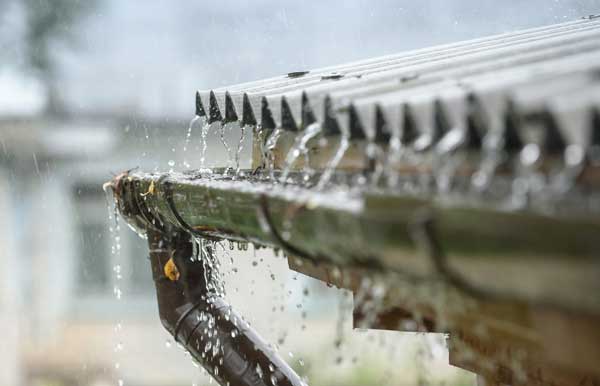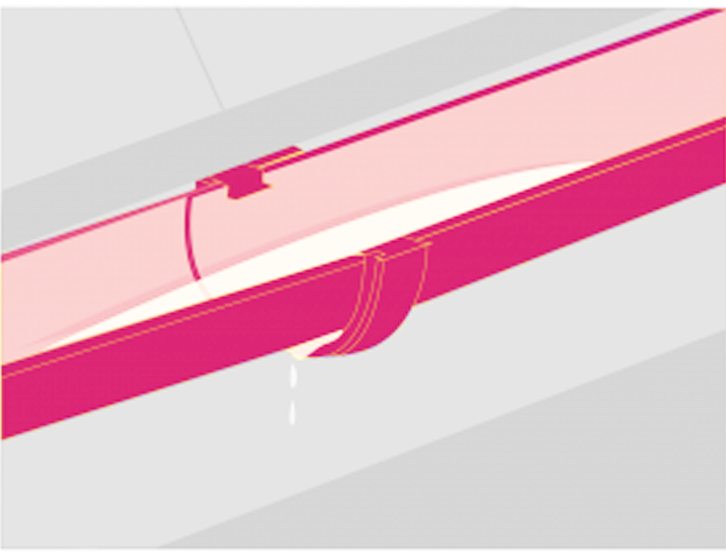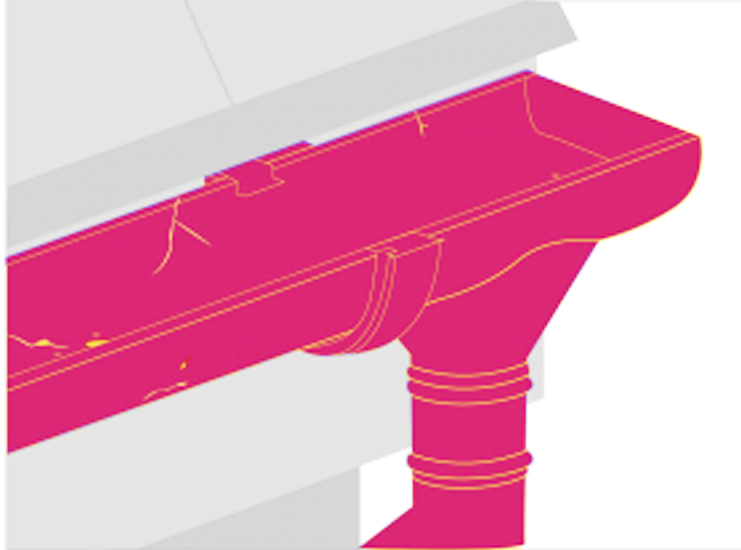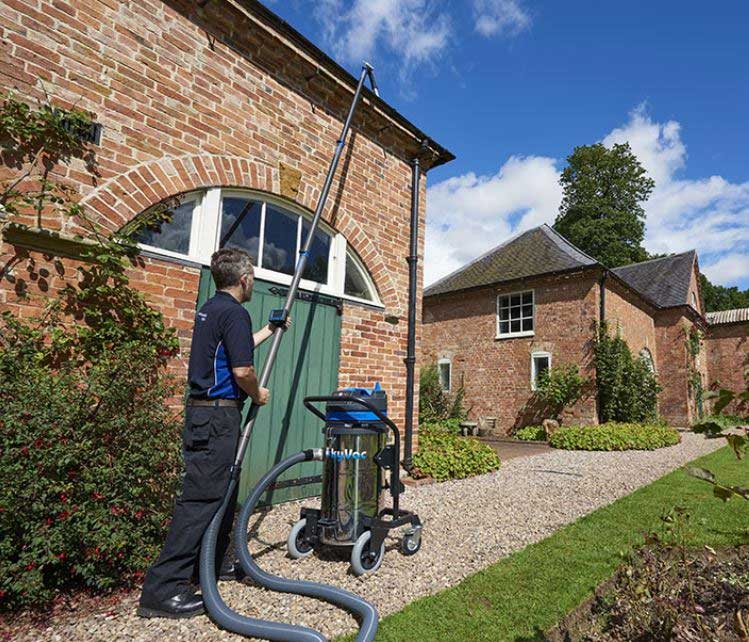Leaking gutters are the last thing you need. Whether the cause is rust, objects hitting the guttering system or general wear and tear, you’ll need to deal with the issues as soon as possible. If you don’t, your home is at risk of dampness and flooding, depending on where the water is pooling. That’s why we’ve put together this gutter repair guide to help you know how to deal with the issues at hand.
Table of contents
- Why you should keep your gutter clean and repair damages
- How is gutter damage caused?
- How to repair gutter systems
- How much will my gutter repair cost?
Why you should keep your gutter clean and repair damages
Aesthetically, it is not the best practice to leave your gutters unclean and in disrepair. You can end up with damp stains on your walls and a horrid damp smell. Not great if you’re living or working in a space long-term. However, the aesthetics might be the least of your worries, as you can see below.
What damage can a leaking gutter cause?
Leaking gutters are an absolute nightmare for many reasons, including structural and aesthetic ones. If you discover a leaking gutter, the water won’t pass through the system effectively. This will encourage the water to flow and pool elsewhere.
When gutters are not working efficiently, the water passes over the roof and fascia. This often leads to wooden structural elements rotting, leading to possible structural instability. Alternatively, the water could run down the side of the building and pool at the side of it, leading to basement and/or building floods. At worst the building’s foundations become affected.
Additionally, the running water can pass down onto timber decking and porches and cause rot as a result.
How is gutter damage caused?
Damage isn’t limited to one cause. The type of damage is also depending on the weather. Here’s a list of common causes of a leaking gutter and how to spot them.

Blocked gutter systems
One of the most common issues is blocked gutters, caused by debris building up over time. This blockage prevents water from running through the guttering system, causing it to spill over the gutter’s sides. An additional problem with this is it can cause splitting because of the weight of the water and debris together.

The gutter is incorrectly installed
Even with their simple fitting, gutters can still be incorrectly installed, further complicating their performance. If the gutter has not been installed with a slight pitch to allow water to flow towards the downpipe, you’ve got a problem. That problem is standing water. This is caused by the water not flowing from the gutter efficiently. Worse yet, with standing water comes pressure on the gutter joints and gutter clips, causing them to crack or split under the water’s weight. This risk increases when heavy rain is apparent as it heightens the chance of damage.

There’s a faulty gutter joint
With their everyday use, gutter joints can succumb to wear and tear. As they deteriorate, they can start struggling as a joining piece between two sections of guttering. This leads to leaking gutter joints, meaning rainwater can pass through the joint space. A main cause of gutter joint wear is the gutter sections themselves. Many materials are manufactured with the ability to expand and contract when exposed to certain temperatures. This can, in turn, weaken the joint seals, leading to spaces allowing rainwater to pass through.

A hole is in the gutter
Holes aren’t uncommon, particularly within gutter runs. The main causes can be corrosion, wear and tear of the gutter material and, in some cases, sharp objects falling and damaging the gutter. This allows the water to leave the system through those holes rather than along the gutter run to the downpipe; therefore, becoming a leaking gutter.

How to repair gutter systems
You’ve found the cause, so what’s your next move? Well, here’s a breakdown of the ways you can repair your gutter with some quick and easy steps depending on the type of damage.
Repairing blocked gutter systems
If leaves, twigs and other debris have clogged up the system.
What you’ll need
- Protective gloves
- Small trowel (optional)
- Rake or brush (for the roof)
- A stable ladder
- Tarpaulin or a bucket (to collect the debris)
- A short piece of timber (if needed)
- Screwdriver
- Leaf guard or leaf brush (optional).
Step one: Place your ladder on a stable surface to access the gutter. If you need to lean it against the guttering, place a short piece of timber within the gutter to reinforce it in the meantime. If you have an extension ladder, obtain clips or stabilisers to steady the ladder and avoid damaging the gutter.
Step two: Lay down the tarpaulin or set up your bucket to hold the debris. If you are opting for tarpaulin, this will make collecting it easier and prevent it from spreading across the garden. Alternatively, you can hook a bucket to the top of your ladder to collect the debris.
Not sure what tarpaulin you need? Check out our tarpaulin buyer’s guide to discover the right tarp for your gutter repairs.
Step three: Put on your protective gloves and brush away debris from the roof. Get stuck in removing as many leaves and debris off the roof as possible. This can help prevent the debris from falling into the gutter over the next few days or weeks.
Step four: While still wearing your protective gloves, remove the debris. The gloves will protect you from any sharp objects, such as screws. Put the debris in the bucket or drop it on the tarpaulin (whichever you have chosen).
You can also opt for a SkyVac gutter cleaning system. It can help you easily access your gutters to clean the guttering on a larger scale and give you regular access to cleaning. It has a high reach, consisting of poles, vacuums, tools and accessories.
Step five: Now you’ve cleared the gutter of debris, you can clean the downpipe. This will help to ensure the water can move through the system efficiently for a longer period. Using your screwdriver, loosen the downpipe clips and brackets to dismantle the downpipe. Dislodge any debris using a wire, stick or hose. Once clear, you can reconnect the downpipe to the system.
Step six (optional): Fit a leaf guard or gutter brush. These can work wonders, preventing blockages and ensuring clearing out your gutter is much easier overall.
As a rule, keep your gutter clean as regularly as possible. Leaving leaves and debris can cause the gutter to sag over time and lead to further issues such as leaking gutter joints, splitting of the gutter or collapsing under the weight.
You can discover more about cleaning gutters in our how to clean and repair gutters guide.

Repairing a gutter that is incorrectly installed
Without a correct fall, the gutter won’t allow water to run through the system efficiently. So, how do you tackle this? Readjust the gutter so there is a slight fall, making sure it angles towards the rainwater outlet. That way, rainwater can run through the system more efficiently, preventing leaks.
Repairing faulty gutter joints
This can be one of the easiest repairs in some cases. All you need is protective gloves and gutter sealant.
Step one: Remove any dirt or debris from the gutter joint using a wire brush. Ensure the joint is dry after doing so.
Step two: Apply gutter sealant to the joint, squeezing the gutter pieces together to strengthen the connection.
This should do the trick. However, if the guttering connects via a union clip, you may need to replace this if it’s damaged.
Repairing holes in gutters
Small holes aren’t something to ignore and can be easy to deal with using roof and gutter sealant to fill them in. Having said that, if the holes are a little larger, use glass-fibre filler to seal the holes temporarily or replace the section entirely.
If the gutter is cast iron and you’re noticing rust on the surface, don’t ignore this, as it can lead to damage and more holes. So, how do you repair this? Smooth off the patch or rust using a wire hand brush. Then apply a coat of metal primer and paint it for good measure.
Repairing leaking gutter ends
You may notice your gutter leaking at the end. This is likely due to a damaged stop end or the piece has fallen off completely. To deal with this, install a new stop end at the end of the gutter run. This should allow the water to divert into the downpipe as needed.
How much will my gutter repair cost?
The repair cost will depend on the materials and amount of labour required for the job. If you’re repairing it yourself, you’ve knocked the price down a little already. For the parts, you’re going to want to explore your options. See what fits your system and, from there, make a purchase ideal for you.
If you’re contacting a professional for gutter repair, you can request a quote from them as needed to find a cost suited to your budget.
Here are some examples of products and the varying prices you can find right here at our Roofing Superstore. You can explore our range for more options suited to your needs.
Aluminium guttering
Cast iron guttering
Copper guttering
| Gutter type | Price (ex VAT) |
| Coppa Gutta Box Gutter | £58.65 |
| Coppa Gutta Ogee Gutter | £70.15 |
| Lindab Copper Half Round Gutter | £91.67 |
| Copper Guttering Square 80x80mm Downpipe 2.4m Length | £85.10 |
| Copper Guttering Self Sealing Stop End Lindab Rainline - 125mm | £12.08 |
| Coppa Gutta Hopper Head | £63.25 |
| Lindab Copper Half Round Gutter Fascia Bracket | £17.08 |
| Lindab Copper Half Round Gutter 210mm Rafter Bracket | £26.67 |
Plastic guttering
Steel guttering
Zinc guttering
| Gutter type | Price (ex VAT) |
| Zinc Gutta Box Gutter | £35.89 |
| Zinc Gutta Half Round Gutter | £35.89 |
| Zinc Gutta Ogee Gutter | £43.44 |
| Zinc Gutta 80mm Diameter Downpipe - 2400mm Length | £39.67 |
| Zinc Gutta Box Gutter Stop End | £4.72 |
| Zinc Gutta Hopper Head | £143.56 |
| Zinc Gutta Box Gutter Fascia Bracket | £6.62 |
| Zinc Gutta Box Gutter Roof Bracket | £8.51 |
Need to know gutter sizes? We’ve got you covered with this handy guide, as well as plenty more Help and Advice guides dedicated to giving you efficient support with your project.



















